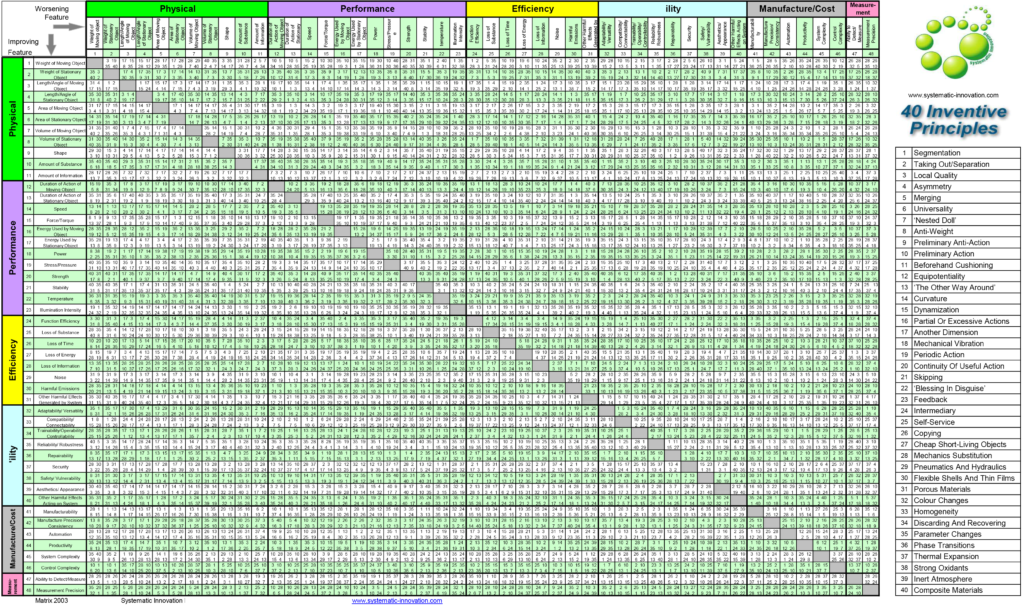When talking about creativity, many people will tell you: “Think outside the box!” The catchphrase is so common in management consulting and business environments, it has become a bit of a cliché. What if innovation could be fostered by thinking inside the box instead? That’s what Systematic Inventive Thinking (SIT) aims to achieve.
The history of Systematic Inventive Thinking
SIT has an interesting background. In the 1940’s, a Russian engineer named Genrich Altshuller worked with colleagues to analyse over 200,000 patents to identify the formula of innovation. They identified 40 common inventive principles, such as “The Other Way Around”, “Blessing in Disguise”, and “Continuity of Useful Action.”
These 40 inventive principles were combined to create a creativity equation named the Theory of Inventive Problem Solving, better known by its Russian acronym: TRIZ. As you can imagine, the equation is fairly complex. I mean, look at this matrix derived as an extension of the 40 principles.

Based on TRIZ, SIT was designed as a more practical approach to innovation. One key change makes SIT a powerful creativity tool: instead of thinking outside the box, using the SIT methodology requires you to think inside the box.
The “closed-world condition” means that, when addressing a problem or trying to improve a product, you must use only elements already existing in the product or problem, or in the immediate environment.
Thinking inside the box necessitates a shift in mindset: one that states that all the building blocks for innovation are right there in front of you, and that the solution only requires the reorganisation of existing elements.
The benefits of thinking inside the box
While thinking inside the box may not feel like a natural approach to innovation—especially when we have been told our whole life to think outside the box—it has many benefits which become evident once we understand that constraints can foster creativity.
- Fun puzzle. When you try to solve a puzzle, you can’t just go and borrow pieces from another puzzle. You have to solve it using the provided pieces. Thinking inside the box is akin to solving a fun puzzle. The constraint makes it interesting to find a solution within the boundaries of the “problem world.”
- Increased focus. Thinking inside the box is a more focused innovation approach where we are encouraged to reconsider elements within the problem world and to pay closer attention to them.
- Forcing mechanism. We have all participated in team brainstorming sessions when we end up with a seemingly infinite list of random ideas which don’t solve the problem at hand, a phenomenon due to Parkinson’s Law. By artificially limiting the scope of possibilities, thinking inside the box helps us get to a solution much quicker than traditional brainstorming.
Instead of importing external resources to find a solution, using SIT to think inside the box makes us rely on resources already at our disposal. And the process is surprisingly similar to solving an equation.
The innovation equation
SIT is based on five thinking tools to consider the relations between elements found within the problem world, paying attention to their assigned functions, their arrangement in space and time, and their necessity.
- Subtraction. Is there anything you can remove from the equation? Many innovative products have disrupted their space by removing something. In an industry where recorders were the most popular product, Sony removed the recording function to launch a new product: the Walkman. The iPhone was denounced by customers for getting rid of the headphone jack, but it helped democratise the highly successful AirPods. Software like Simple Analytics or Fathom Analytics are carving a niche for developers who want less data from their users.
- Multiplication. Is there any element you can multiply? For instance, doubling battery life, offering a bigger package, giving longer coaching sessions. Retina screens are the result of a multiplication of the number of pixels, leading to increased sharpness. Dropbox stayed competitive by increasing storage space for their users over the years. Note that it is not about adding a new element, but multiplying an existing one.
- Division. By dividing a problem or product into smaller elements, you can then reorganise them to find a solution or form a new product. Dividing a laptop into smaller elements and extracting the screen will give you a tablet. You may want to keep the keyboard but separate it from the screen—that’s what Microsoft did with the Surface. Dividing a fridge and extracting a drawer will give you a cooling drawer. Dividing food into its nutrients will give you nutritional supplements.
- Task unification. Can several tasks be unified under a single element? USB-C can transmit both data and power on a single cable. Dyson has created air purifiers that can both cool and heat your house. Smart speakers can play sound and listen to your voice. The home button of the iPhone performs several functions depending on how you press it.
- Attribute dependency. Many products have internal and external dependencies. Breaking these dependencies or creating new intentional dependencies can lead to innovation. For instance, putting a phone in the water used to destroy it. Breaking this dependency has led to waterproof smartphones. Creating a dependency between light levels and the shade of the glass has led to transition sunglasses. Windshield wipers on a car that change speed as the amount of rain changes is a form of attribute dependency.
Thinking inside the box often provokes resistance as it runs counter to some of the most ubiquitous intuitions about innovation. However, it’s a formidable creative thinking tool which is actually fun to use. Next time someone tells you to think outside the box, try to suggest thinking inside the box instead.
